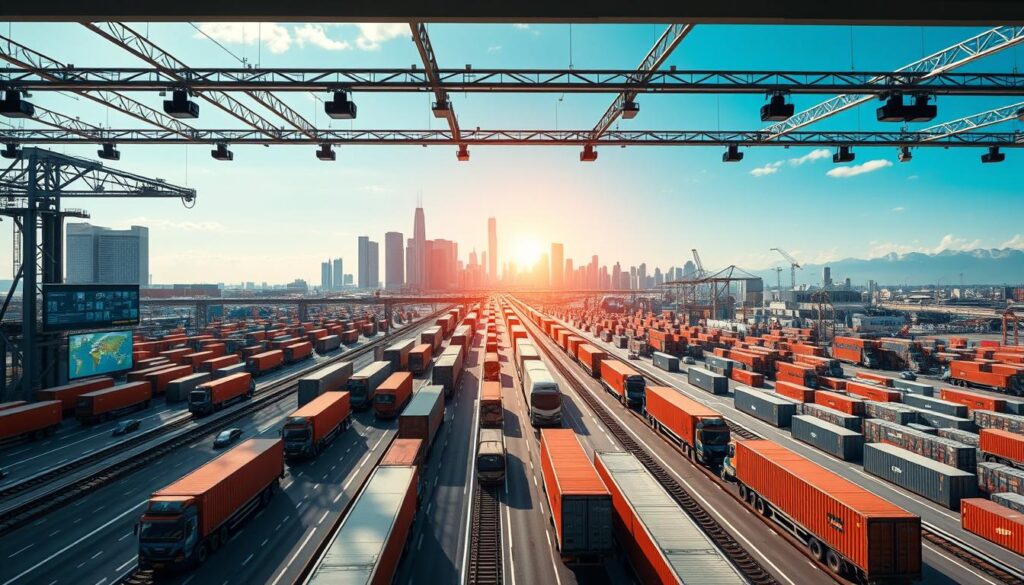Can your supply chain keep up with the demands of today’s fast-paced global market? As global supply chains become increasingly complex, the need for efficiency and agility has never been more critical.
According to Deloitte, “Global supply chains can be planned with great precision. However, unpredictable environments and rising consumer demands require unprecedented efficiency and agility to react to changing network conditions with dynamic decisions.” This is where logistics optimization plays a crucial role in enhancing supply chain efficiency.
Industries are now leveraging logistics analytics and technology to make informed decisions, ensuring they stay ahead in the competitive landscape. By optimizing their transportation networks, businesses can achieve significant improvements in their overall supply chain performance.
Key Takeaways
- Understanding the importance of transportation network optimization in modern supply chains.
- The role of logistics analytics in making informed decisions.
- Steps to achieve freight optimization, including data analysis and carrier performance tracking.
- The benefits of using beneficial technology tools for transportation network optimization.
- Examples of effective KPIs for measuring carrier performance.
Understanding Transportation Network Optimization
In today’s fast-paced business environment, optimizing transportation networks has become essential for companies seeking to enhance their supply chain efficiency. Transportation network optimization involves the strategic planning and management of transportation resources to achieve cost savings, improve delivery times, and increase overall supply chain resilience.
What is Transportation Network Optimization?
Transportation network optimization refers to the process of strategic transportation planning to maximize the efficiency of the transportation network. This involves analyzing various factors such as transportation modes, routes, and carrier options to identify the most cost-effective and efficient ways to move goods. By leveraging advanced analytics and optimization techniques, businesses can streamline their transportation operations, reduce transit times, and lower transportation costs.
Importance in Supply Chain Management
The importance of transportation network optimization in supply chain management cannot be overstated. An optimized transportation network is crucial for achieving transportation cost reduction, improving delivery times, and enhancing customer satisfaction. According to a study on logistics network optimization, companies that implement effective transportation strategies can achieve significant cost savings and improvements in supply chain efficiency. For more insights, visit Understanding Logistics Network Optimization.
| Benefits | Description | Impact |
|---|---|---|
| Cost Reduction | Optimizing routes and modes of transport | Significant reduction in transportation costs |
| Improved Delivery Times | Streamlining logistics and transportation operations | Faster delivery times, enhanced customer satisfaction |
| Supply Chain Resilience | Implementing contingency plans and risk management strategies | Increased resilience to supply chain disruptions |
By understanding and implementing transportation network optimization, businesses can achieve a competitive edge in the market. It is a critical component of a comprehensive supply chain strategy, enabling companies to respond more effectively to changing market conditions and customer demands.
Key Components of Transportation Networks
A well-optimized transportation network is essential for reducing costs, improving delivery times, and enhancing overall supply chain resilience. To achieve this, it’s crucial to understand the key components that make up these networks.
Modes of Transportation
Transportation networks rely on various modes of transport, including road, rail, air, and sea. Each mode has its advantages and is suited for different types of cargo and delivery requirements. For instance, road transport offers flexibility and is ideal for last-mile deliveries, while rail transport is more efficient for long-distance hauls of bulk goods.
The choice of transportation mode significantly impacts logistics optimization. By selecting the most appropriate mode or combination of modes, businesses can achieve route optimization and reduce transit times.

Infrastructure and Connectivity
The infrastructure and connectivity within a transportation network are critical for its efficiency. This includes roads, railways, ports, and airports, as well as the technology that connects these elements, such as transportation management systems (TMS) and real-time tracking solutions.
A well-designed network with robust infrastructure and connectivity enables smooth transitions between different modes of transport, facilitating network design that is both efficient and resilient.
| Infrastructure Element | Importance | Impact on Logistics |
|---|---|---|
| Roads | High | Enables efficient last-mile delivery |
| Railways | High | Facilitates long-distance transport of bulk goods |
| Ports and Airports | High | Critical for international trade and cargo transport |
Data Management in Logistics
Effective data management is the backbone of modern logistics. It involves collecting, analyzing, and using data to optimize logistics operations. This includes data on transportation modes, routes, schedules, and cargo, as well as real-time information on traffic, weather, and other factors that can impact delivery.
By leveraging advanced analytics and data management tools, businesses can achieve logistics optimization through better planning, execution, and monitoring of their transportation networks. For more insights on successful network design, visit Tompkins Inc.
Benefits of Optimizing Your Transportation Network
Effective transportation network optimization can transform the way businesses operate, leading to enhanced customer satisfaction and reduced costs. By streamlining logistics and transportation operations, companies can achieve significant improvements in their overall supply chain efficiency.
Cost Reduction Strategies
One of the primary benefits of transportation network optimization is the potential for substantial cost savings. By optimizing routes and minimizing fuel consumption, businesses can experience significant cost savings in transportation, often up to 20% or more. This is achieved through:
- Route optimization to reduce mileage and lower fuel costs
- Improved load planning to maximize vehicle capacity
- Enhanced carrier management to negotiate better rates
Cost reduction is a critical aspect of transportation network optimization. By implementing these strategies, businesses can significantly lower their transportation costs and improve their bottom line.
Improved Delivery Times
Optimizing transportation networks also leads to improved delivery times. By streamlining logistics operations and reducing transit times, businesses can ensure that their products reach customers faster and more reliably.
| Delivery Metric | Before Optimization | After Optimization |
|---|---|---|
| Average Delivery Time | 5 days | 3 days |
| On-Time Delivery Rate | 85% | 95% |
| Transit Time Variability | High | Low |
Enhanced Customer Satisfaction
Finally, transportation network optimization can lead to enhanced customer satisfaction. By providing faster and more reliable delivery, businesses can improve customer satisfaction and build loyalty.
By focusing on cost reduction strategies, improving delivery times, and enhancing customer satisfaction, businesses can reap the benefits of transportation network optimization and improve their overall supply chain efficiency.
Common Challenges in Transportation Networks
Transportation networks face numerous challenges that can significantly impact their efficiency and effectiveness. These challenges can range from operational issues to external factors, all of which can affect the overall performance of the network.
Traffic Congestion
One of the most significant challenges is traffic congestion, which can lead to delays and increased costs. Efficient route planning is crucial in mitigating this issue. By utilizing logistics optimization techniques, transportation networks can reduce congestion and improve delivery times.

Inefficient Routing
Inefficient routing is another challenge that can result in increased fuel consumption and longer delivery times. Implementing route optimization software can help in identifying the most efficient routes, thereby reducing costs and enhancing customer satisfaction.
Seasonal Demand Fluctuations
Seasonal demand fluctuations pose a significant challenge as they require transportation networks to be highly adaptable. By analyzing historical data and implementing flexible supply chain network strategies, companies can better manage these fluctuations and maintain efficient operations.
| Challenge | Impact | Potential Solution |
|---|---|---|
| Traffic Congestion | Delays, Increased Costs | Efficient Route Planning, Logistics Optimization |
| Inefficient Routing | Increased Fuel Consumption, Longer Delivery Times | Route Optimization Software |
| Seasonal Demand Fluctuations | Operational Inefficiencies | Flexible Supply Chain Strategies, Historical Data Analysis |
Strategies for Effective Network Optimization
In today’s fast-paced business environment, optimizing your transportation network is no longer a luxury, but a necessity. To achieve this, companies must adopt a multifaceted approach that incorporates advanced strategies and technologies.
Data analysis and real-time tracking are crucial components of effective network optimization. By leveraging data analytics, businesses can gain insights into their transportation operations, identify bottlenecks, and make informed decisions. “Data is the new oil,” as the saying goes, and in logistics, it’s the key to unlocking efficiency and reducing costs.
Data Analysis and Real-Time Tracking
Implementing a robust data analysis system allows companies to track their shipments in real-time, monitor traffic patterns, and adjust routes accordingly. This not only improves delivery times but also enhances customer satisfaction. According to a recent study, companies that use real-time tracking see a significant reduction in delivery times and costs.
Implementing Route Optimization Software
Route optimization software is another vital tool in strategic transportation planning. This software uses complex algorithms to determine the most efficient routes for deliveries, taking into account factors like traffic, road conditions, and time windows. By optimizing routes, businesses can reduce fuel consumption, lower emissions, and improve overall efficiency.
For instance, a logistics company that implemented route optimization software was able to reduce its fuel costs by 15% and improve delivery times by 20%. This demonstrates the tangible benefits of investing in logistics optimization technologies.
Collaborating with Logistics Partners
Collaboration with logistics partners is also essential for effective network optimization. By working closely with carriers, warehouses, and other stakeholders, businesses can create a more streamlined and efficient supply chain. This involves sharing data, coordinating schedules, and aligning goals to achieve mutual benefits.
As noted by a logistics expert, “Collaboration is key to achieving a seamless and efficient supply chain. By working together, businesses can overcome challenges and capitalize on opportunities.” Effective collaboration can lead to improved service levels, reduced costs, and enhanced customer satisfaction.
In conclusion, effective network optimization requires a combination of data analysis, route optimization software, and collaboration with logistics partners. By adopting these strategies, businesses can achieve significant improvements in their transportation operations and stay competitive in a rapidly changing market.
The Role of Technology in Transportation Optimization
The role of technology in transportation optimization cannot be overstated, as it brings about significant improvements in supply chain efficiency. By leveraging advanced technologies, businesses can streamline their logistics operations, reduce costs, and enhance customer satisfaction.

Artificial Intelligence and Machine Learning
Artificial intelligence (AI) and machine learning (ML) are transforming the transportation landscape by enabling predictive analytics and real-time decision-making. These technologies help in:
- Predicting demand fluctuations
- Optimizing routes in real-time
- Improving delivery times
According to a recent study, companies that have adopted AI and ML in their transportation networks have seen a significant reduction in operational costs and an improvement in delivery times.
Fleet Management Solutions
Fleet management solutions are crucial for efficient transportation optimization. These solutions involve:
- GPS tracking and monitoring
- Vehicle maintenance scheduling
- Driver performance analysis
Fleet management software helps in reducing fuel consumption, lowering emissions, and improving overall fleet productivity.
Transportation Management Systems (TMS)
Transportation Management Systems (TMS) are designed to optimize transportation operations by:
- Automating logistics processes
- Providing real-time visibility
- Enabling better decision-making
TMS solutions are essential for businesses looking to improve their supply chain efficiency and reduce transportation costs.
In conclusion, technology plays a vital role in transportation optimization, and its adoption is crucial for businesses aiming to stay competitive in the market.
Case Studies: Successful Transportation Optimization
By examining real-life case studies, we can gain valuable insights into successful transportation optimization strategies. Companies across various industries have implemented transportation network optimization techniques to improve their logistics and supply chain efficiency.
Real-Life Success Stories
Several industry leaders have achieved significant benefits through transportation optimization. For instance, a leading e-commerce company reduced its shipping costs by 15% by implementing a dynamic routing system. Another example is a manufacturing firm that improved its delivery times by 20% through the use of advanced transportation management systems (TMS).
Lessons Learned from Industry Leaders
Industry leaders have shared valuable lessons learned from their experiences with transportation optimization. One key takeaway is the importance of data analysis and real-time tracking in identifying areas for improvement. According to a report by Ryder, companies that leverage data analytics in their transportation networks can achieve significant cost savings and efficiency gains. You can download the full report from their website.
| Company | Industry | Optimization Benefit |
|---|---|---|
| XYZ Inc. | E-commerce | 15% reduction in shipping costs |
| ABC Manufacturing | Manufacturing | 20% improvement in delivery times |
| DEF Logistics | Logistics | 12% decrease in fuel consumption |
These case studies demonstrate the potential of transportation network optimization to drive business success.
Future Trends in Transportation Network Optimization
Future trends in transportation network optimization are poised to redefine the industry with a focus on sustainability and innovation. As the transportation sector continues to evolve, several emerging trends are expected to play a crucial role in shaping the future of network optimization.
Sustainability and Green Logistics
The transportation industry is under increasing pressure to reduce its environmental footprint. Sustainability and green logistics are becoming key focus areas, with companies investing in alternative fuels, electric vehicles, and more efficient routing to minimize emissions.
According to a recent study, the adoption of green logistics practices can significantly reduce carbon emissions. For instance, optimizing routes can lead to a decrease in fuel consumption, thereby lowering emissions.
“The shift towards sustainability is not just a trend; it’s a necessity. Companies that embrace green logistics will not only contribute to a healthier planet but also gain a competitive edge in the market.”
Autonomous Vehicles in Transportation
Autonomous vehicles are another significant trend that is expected to transform the transportation landscape. With the ability to operate around the clock without human intervention, autonomous vehicles can enhance efficiency and reduce labor costs.
| Benefits | Description |
|---|---|
| Increased Efficiency | Autonomous vehicles can operate continuously, improving delivery times. |
| Reduced Labor Costs | By minimizing the need for human drivers, companies can save on labor costs. |
| Enhanced Safety | Autonomous vehicles can detect and respond to hazards more quickly than human drivers. |
The Impact of E-Commerce on Transportation
The rise of e-commerce has had a profound impact on transportation networks, with increased demand for fast and flexible delivery options. This trend is driving the need for more sophisticated transportation management systems that can handle complex logistics challenges.

As e-commerce continues to grow, transportation networks will need to adapt to meet changing consumer expectations, including faster delivery times and greater transparency throughout the shipping process.
Regulatory Considerations in Transportation
Effective strategic transportation planning requires a deep understanding of regulatory compliance. The transportation industry is subject to a myriad of regulations that impact every aspect of logistics optimization, from safety standards to environmental concerns.
Understanding Compliance and Regulations
Compliance with transportation regulations is not just about avoiding fines; it’s about ensuring the smooth operation of the supply chain network. Regulations can vary significantly by country and even by region within a country, making it crucial for logistics providers to stay informed.
For instance, in the United States, the Federal Motor Carrier Safety Administration (FMCSA) sets strict guidelines for hours of service, driver qualifications, and vehicle maintenance. Compliance with these regulations is essential for maintaining operational efficiency and avoiding costly penalties.
“Regulatory compliance is a critical component of a successful transportation strategy. It not only ensures safety but also enhances the overall efficiency of the supply chain.”
| Regulation | Description | Impact on Logistics |
|---|---|---|
| Hours of Service | Regulates the number of hours a driver can operate a vehicle. | Impacts delivery times and scheduling. |
| Driver Qualifications | Sets standards for driver training and experience. | Enhances safety and reduces liability. |
| Vehicle Maintenance | Requires regular maintenance checks on vehicles. | Reduces the risk of accidents and downtime. |
Safety Standards and Procedures
Safety is a paramount concern in the transportation industry. Implementing robust safety standards and procedures is crucial for protecting drivers, cargo, and the general public.
One key aspect of safety regulations is the mandatory use of Electronic Logging Devices (ELDs) to track driver hours and ensure compliance with hours of service regulations. ELDs have been shown to reduce driver fatigue and improve overall road safety.
By understanding and adhering to regulatory considerations, transportation companies can not only avoid legal issues but also improve their operational efficiency and contribute to a safer transportation network.
Cross-Border Transportation Challenges
As global trade continues to expand, the importance of efficient cross-border transportation cannot be overstated. Businesses looking to thrive in the international market must navigate the complexities of transporting goods across borders.
Cross-border transportation involves more than just moving goods from one place to another; it requires a deep understanding of the regulations, logistics, and potential hurdles that can impact the delivery of goods.
Customs and Duties
One of the significant challenges in cross-border transportation is navigating customs and duties. Different countries have varying regulations and tariffs that can complicate the shipping process.
- Understanding the specific customs regulations of the countries involved in the shipping process.
- Accurately calculating duties and taxes to avoid unexpected costs.
- Ensuring compliance with all relevant documentation requirements.
To overcome these challenges, businesses can leverage transportation network design strategies that optimize their logistics operations.
Managing International Logistics
Managing international logistics is another critical aspect of cross-border transportation. It involves coordinating with various stakeholders, including suppliers, carriers, and customs brokers, to ensure smooth delivery.

Effective management of international logistics requires:
- Implementing robust logistics management systems.
- Building strong relationships with logistics partners.
- Utilizing data analytics to optimize logistics operations.
By addressing these challenges, businesses can improve their supply chain efficiency and maintain a competitive edge in the global market.
The Importance of Training and Development
Training and development are key to unlocking the full potential of strategic transportation planning. In the ever-evolving landscape of logistics, having a well-trained workforce is crucial for maintaining a competitive edge.
The transportation sector faces unique challenges, from managing complex supply chain networks to ensuring timely deliveries. Effective training programs help employees navigate these challenges by enhancing their skills and knowledge.
Workforce Skills in Transportation
The success of logistics optimization heavily relies on the skills and expertise of the workforce. Employees need to be adept in using various tools and technologies, such as transportation management systems (TMS) and data analytics platforms.
Training programs should focus on developing both technical and soft skills. For instance, understanding data analysis and interpretation is crucial for making informed decisions in strategic transportation planning.
Continuous Improvement Programs
Continuous improvement is vital in the transportation sector, where conditions and challenges are constantly changing. Implementing continuous improvement programs encourages employees to identify areas for enhancement and propose innovative solutions.
These programs not only improve operational efficiency but also foster a culture of excellence within the organization. By regularly assessing and refining their processes, companies can achieve significant gains in logistics optimization.
In conclusion, investing in training and development is essential for transportation companies aiming to optimize their networks. By enhancing workforce skills and promoting continuous improvement, businesses can achieve greater efficiency and stay competitive in the market.
Measuring Success in Transportation Optimization
Measuring the success of transportation optimization strategies is vital for companies to stay competitive in the market. To achieve this, businesses must focus on tracking key metrics that reflect the efficiency and effectiveness of their transportation networks.
Effective transportation network optimization involves more than just reducing costs; it’s about creating a streamlined logistics process that enhances overall supply chain efficiency. By leveraging the right tools and indicators, companies can gain valuable insights into their transportation operations.
Key Performance Indicators (KPIs)
KPIs are crucial for evaluating the performance of transportation networks. Some of the most important KPIs include:
- On-time delivery rates
- Transportation cost as a percentage of sales
- Average transit times
- Freight spend by mode
- Order fulfillment cycle time
By monitoring these KPIs, logistics managers can identify areas for improvement and implement strategies to optimize their transportation networks. For more insights on logistics network optimization, you can refer to 5 keys to logistics network optimization.

Tools for Analyzing Performance
In addition to KPIs, various tools can help analyze the performance of transportation networks. These include:
- Transportation Management Systems (TMS)
- Data analytics software
- Real-time tracking systems
These tools enable businesses to make data-driven decisions, reduce costs, and improve customer satisfaction by ensuring timely deliveries. Implementing the right combination of KPIs and analytical tools is key to achieving logistics optimization and maintaining a competitive edge in the market.
By focusing on measuring success through KPIs and advanced analytical tools, companies can drive continuous improvement in their transportation networks, ultimately enhancing their overall supply chain efficiency.
Transportation Network Design Principles
Transportation network design principles are essential for creating a robust and cost-effective supply chain. A well-designed network enables businesses to optimize their logistics operations, reduce costs, and improve customer satisfaction.
Network Structure and Layout
The structure and layout of a transportation network are critical components that determine its efficiency. A good network design should consider factors such as the location of facilities, transportation modes, and routing strategies. For instance, a hub-and-spoke model can be effective for managing large volumes of goods across long distances.
By analyzing the network structure, companies can identify opportunities to consolidate shipments, reduce transit times, and lower costs. It’s also important to consider the flexibility of the network to accommodate changes in demand or supply chain disruptions.
Balancing Cost and Service Levels
One of the key challenges in transportation network design is balancing cost and service levels. Companies need to ensure that their network is cost-effective while also meeting customer expectations for delivery times and service quality. This can be achieved by implementing strategies such as route optimization and transportation management systems.
By leveraging advanced technologies and data analytics, businesses can gain insights into their network performance and make informed decisions to optimize their operations. For example, using data analytics tools, companies can analyze traffic patterns, road conditions, and other factors to determine the most efficient routes.
Effective transportation network design requires a thorough understanding of the supply chain and logistics operations. By applying the principles of network design, businesses can create a more efficient, cost-effective, and responsive supply chain that meets customer needs and drives business success.
Leveraging Data for Transportation Decisions
Data-driven insights are revolutionizing the way transportation networks are optimized. By leveraging various data sources and analytics tools, logistics companies can make informed decisions that enhance efficiency and reduce costs.
Data Sources for Optimization
Effective transportation decisions rely on diverse data sources. These include:
- GPS tracking data
- Historical transportation data
- Real-time traffic updates
- Weather forecasts
- Customer demand data
By integrating these data sources, companies can gain a comprehensive understanding of their transportation networks and identify areas for improvement.

Analytics Tools and Solutions
Advanced analytics tools play a crucial role in transportation network optimization. Some of the key solutions include:
- Route optimization software
- Predictive analytics for demand forecasting
- Real-time monitoring and alert systems
These tools enable logistics companies to analyze complex data sets, identify patterns, and make data-driven decisions.
| Tool | Primary Function | Benefits |
|---|---|---|
| Route Optimization Software | Optimizes routes for deliveries | Reduces fuel consumption, lowers emissions |
| Predictive Analytics | Forecasts demand and potential disruptions | Improves supply chain resilience, reduces costs |
| Real-Time Monitoring | Tracks shipments in real-time | Enhances customer satisfaction, improves delivery times |
Engaging Stakeholders in Transportation Projects
The success of transportation projects heavily relies on the engagement of stakeholders. Effective stakeholder engagement is crucial for strategic transportation planning and achieving supply chain efficiency. By engaging stakeholders, transportation projects can better meet the needs of all parties involved, leading to improved outcomes.
Building Relationships with Carriers
Building strong relationships with carriers is a vital aspect of stakeholder engagement in transportation projects. Carriers play a critical role in the execution of transportation plans, and their satisfaction can significantly impact logistics optimization. To foster these relationships, it’s essential to maintain open lines of communication and negotiate mutually beneficial agreements.
For more insights on stakeholders in transportation, visit Boreal IS Blog.
| Carrier Engagement Strategies | Benefits | Implementation Tips |
|---|---|---|
| Regular Communication | Improved Trust and Cooperation | Schedule regular meetings and updates |
| Mutually Beneficial Agreements | Enhanced Carrier Satisfaction | Negotiate contracts that consider carrier needs |
| Performance Monitoring | Optimized Logistics Operations | Use data analytics to track carrier performance |
Communication with Customers and Partners
Effective communication with customers and partners is another critical component of stakeholder engagement. By keeping these stakeholders informed, transportation projects can ensure that their needs are met, leading to increased satisfaction and supply chain efficiency. Utilizing various communication channels and being responsive to feedback are key strategies in this regard.
For transportation projects to achieve their full potential, it’s crucial to engage stakeholders effectively. This involves not only building relationships with carriers but also maintaining transparent and effective communication with customers and partners. By doing so, projects can ensure they are meeting the needs of all stakeholders, ultimately leading to more successful outcomes.
Conclusion: Moving Forward with Optimization
As we’ve explored throughout this guide, transportation network optimization is crucial for achieving supply chain efficiency and logistics optimization. By understanding the complexities of transportation networks and implementing effective strategies, businesses can significantly enhance their overall performance.
To stay ahead, it’s essential to embrace change and continually assess and improve transportation networks. This involves leveraging advanced technologies and data analysis to inform decision-making and drive ongoing improvement.
Ongoing Improvement Strategies
Regularly reviewing and refining transportation networks is vital for sustained optimization. This includes monitoring key performance indicators, adopting new technologies, and collaborating with logistics partners to ensure seamless operations.
By prioritizing transportation network optimization and logistics optimization, businesses can reduce costs, improve delivery times, and enhance customer satisfaction, ultimately driving long-term success in an increasingly competitive landscape.
